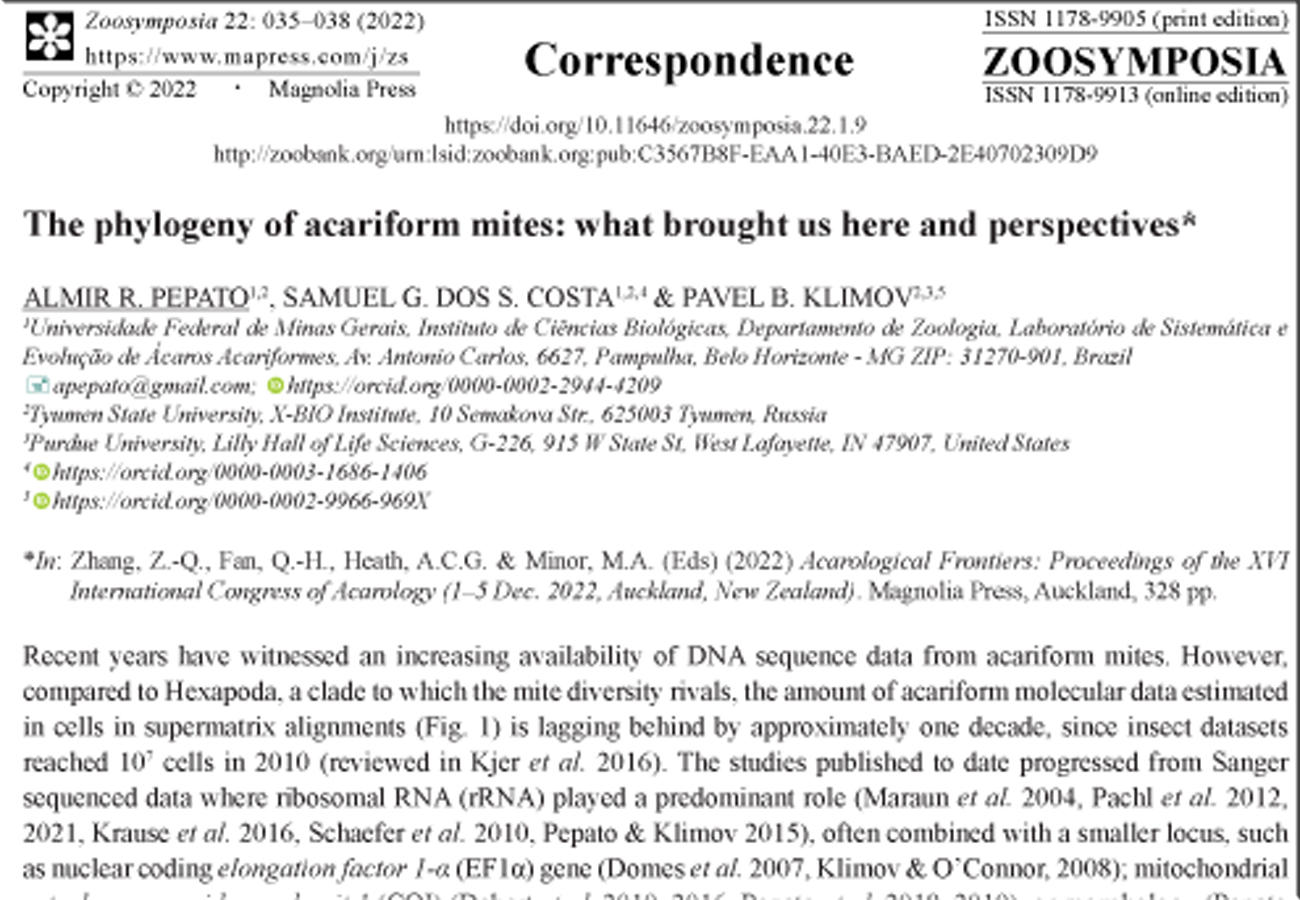Abstract
Recent years have witnessed an increasing availability of DNA sequence data from acariform mites. However, compared to Hexapoda, a clade to which the mite diversity rivals, the amount of acariform molecular data estimated in cells in supermatrix alignments (Fig. 1) is lagging behind by approximately one decade, since insect datasets reached 107 cells in 2010 (reviewed in Kjer et al. 2016).
References
Arribas, P., Andújar, C., Moraza, M.L., Linard, B., Emerson, B.C. & Vogler, A.P. (2020) Mitochondrial metagenomics reveals the ancient origin and phylodiversity of soil mites and provides a phylogeny of the Acari. Molecular Biology and Evolution, 37 (3), 683–694. https://doi.org/10.1093/molbev/msz255
Azevedo, G.H.F., Bougie, T., Carboni, M., Hedin, M. & Ramírez, M.J. (2022) Combining genomic, phenotypic and Sanger sequencing data to elucidate the phylogeny of the two-clawed spiders (Dionycha). Molecular Phylogenetics and Evolution, 166, 107327.https://doi.org/10.1016/j.ympev.2021.107327
Dabert, M., Proctor, H. & Dabert, J. (2016) Higher-level molecular phylogeny of the water mites (Acariformes: Prostigmata: Parasitengonina: Hydrachnidiae). Molecular Phylogenetics and Evolution, 101, 75–90.https://doi.org/10.1016/j.ympev.2016.05.004
Dabert, M., Witalinski, W., Kazmierski, A., Olszanowski, Z. & Dabert, J. (2010) Molecular phylogeny of acariform mites (Acari, Arachnida): strong conflict between phylogenetic signal and long-branch attraction artifacts. Molecular Phylogenetics and Evolution, 56(1), 222–241.https://doi.org/10.1016/j.ympev.2009.12.020
Dong, X., Chaisiri, K., Xia, D., Armstrong, S.D., Fang, Y., Donnelly, M.J., Kadowaki, T., McGarry, J.W., Darby, A.C. & Makepeace, B.L. (2018) Genomes of trombidid mites reveal novel predicted allergens and laterally transferred genes associated with secondary metabolism, GigaScience, 7(12), giy127. https://doi.org/10.1093/gigascience/giy127
Domes, K., Althammer, M., Norton, R.A., Scheu, S. & Maraun, M. (2007) The phylogenetic relationship between Astigmata and Oribatida (Acari) as indicated by molecular markers. Experimental and Applied Acarology, 42(3), 159–171. https://doi.org/10.1007/s10493-007-9088-8
Kjer, K.M., Simon, C., Yavorskaya, M. & Beutel, R.G. (2016) Progress, pitfalls and parallel universes: a history of insect phylogenetics. Journal of the Royal Society Interface, 13, 20160363. https://doi.org/10.1098/rsif.2016.0363
Klimov, P.B. & O’Connor, B.M. (2008) Origin and higher-level relationships of psoroptidian mites (Acari: Astigmata: Psoroptidia): evidence from three nuclear genes. Molecular Phylogenetics and Evolution, 47, 1135–1156.https://doi.org/10.1016/j.ympev.2007.12.025
Klimov, P.B. & O’Connor, B.M. (2013) Is permanent parasitism reversible? Critical evidence from early evolution of house dust mites. Systematic Biology, 62(3), 411–23. https://doi.org/10.1093/sysbio/syt008
Klimov, P.B., Chetverikov, P.E., Dodueva, I.E., Vishnyakov, A.E., Bolton, S.J., Paponova, S.S., Lutova, L.A. & Tolstikov, A.V. (2022) Symbiotic bacteria of the gall inducing mite Fragariocoptes setiger (Eriophyoidea) and phylogenomic resolution of the eriophyoid position among Acari. Scientific Reports, 12, 3811. https://doi.org/10.1038/s41598-022-07535-3
Klimov, P.B., O’Connor, B.M., Chetverikov, P.E., Bolton, S.J., Pepato, A.R., Mortazavi, A.L., Tolstikov, A.V., Bauchan, G.R. & Ochoa, R. (2018) Comprehensive phylogeny of acariform mites (Acariformes) provides insights on the origin of the four-legged mites (Eriophyoidea), a long branch. Molecular Phylogenetics and Evolution, 119, 105–117. https://doi.org/10.1016/j.ympev.2017.10.017
Krause, A., Pachl, P., Schulz, G., Lehmitz, R., Seniczak, A., Schaefer, I., Scheu, S. & Maraun, M. (2016) Convergent evolution of aquatic life by sexual and parthenogenetic oribatid mites. Experimental and Applied Acarology, 70(4), 439–453. https://doi.org/10.1007/s10493-016-0089-3
Li, W.-N. & Xue, X.-F. (2019) Mitochondrial genome reorganization provides insights into the relationship between oribatid mites and astigmatid mites (Acari: Sarcoptiformes: Oribatida). Zoological Journal of the Linnean Society, 187, 585–598. https://doi.org/10.1093/zoolinnean/zlz044
Lozano-Fernandez, J., Tanner, A.R., Giacomelli, M., Carton, R., Vinther, J., Edgecombe, G.D. & Pisani, D. (2019) Increasing species sampling in chelicerate genomic-scale datasets provides support for monophyly of Acari and Arachnida. Nature Communications, 10, 2295. https://doi.org/10.1038/s41467-019-10244-7
Maraun, M., Heethoff, M., Schneider, K., Scheu, S., Weigmann, G., Cianciolo, J., Thomas, R.H. & Norton, R.A. (2004) Molecular phylogeny of oribatid mites (Oribatida, Acari): evidence for multiple radiations of parthenogenetic lineages. Experimental and Applied Acarology, 33(3), 183–201. https://doi.org/10.1023/b:appa.0000032956.60108.6d
Pachl, P., Domes, K., Schulz, G., Norton, R. A., Scheu, S., Schaefer, I. & Maraun, M. (2012) Convergent evolution of defense mechanisms in oribatid mites (Acari, Oribatida) shows no “ghosts of predation past”. Molecular Phylogenetics and Evolution, 65(2), 412–20. https://doi.org/10.1016/j.ympev.2012.06.030
Pachl, P., Uusitalo, M., Scheu, S., Schaefer, I. & Maraun, M. (2021) Repeated convergent evolution of parthenogenesis in Acariformes (Acari). Ecology and Evolution, 11, 321–337. https://doi.org/10.1002/ece3.7047
Pepato, A.R., Costa, S.G.S., Harvey, M.S. & Klimov, P.B. (2022) One-way ticket to the blue: A large-scale, dated phylogeny revealed asymmetric land-to-water transitions in acariform mites (Acari: Acariformes). Molecular Phylogenetics and Evolution, 177, 107626. https://doi.org/10.1016/j.ympev.2022.107626
Pepato, A.R. & Klimov, P.B. (2015) Origin and higher-level diversification of acariform mites – evidence from nuclear ribosomal genes, extensive taxon sampling, and secondary structure alignment. BMC Evolutionary Biology, 15, 178. https://doi.org/10.1186/s12862-015-0458-2
Pepato, A.R., da Rocha, C.E. & Dunlop, J.A. (2010) Phylogenetic position of the acariform mites: sensitivity to homology assessment under total evidence. BMC Evolutionary Biology, 10, 235. https://doi.org/10.1186/1471-2148-10-235
Pepato, A.R., Vidigal, T.H.D.A. & Klimov, P.B. (2018) Molecular phylogeny of marine mites (Acariformes: Halacaridae), the oldest radiation of extant secondarily marine animals. Molecular Phylogenetics and Evolution, 129, 182–188.https://doi.org/10.1016/j.ympev.2018.08.012
Pepato, A.R., Vidigal, T.H.D. & Klimov, P.B. (2019) Evaluating the boundaries of marine biogeographic regions of the Southwestern Atlantic using halacarid mites (Halacaridae), meiobenthic organisms with a low dispersal potential. Ecology and Evolution, 9, 13359-13374. https://doi.org/10.1002/ece3.5791
Schaefer, I., Norton, R.A., Scheu, S. & Maraun, M. (2010) Arthropod colonization of land--linking molecules and fossils in oribatid mites (Acari, Oribatida). Molecular Phylogenetics and Evolution, 57(1), 113–121. https://doi.org/10.1016/j.ympev.2010.04.015
Van Dam, M.H., Trautwein, M., Spicer, G.S. & Esposito.L. (2019) Advancing mite phylogenomics: designing ultraconserved elements for Acari phylogeny. Molecular Ecology Resources, 19, 465–475.https://doi.org/10.1111/1755-0998.12962
Xue, X.-F., Guo, J.F., Dong, Y., Hong, X.-Y. & Shao, R. (2016) Mitochondrial genome evolution and tRNA truncation in Acariformes mites: new evidence from eriophyoid mites. Scientific Reports, 6, 18920. https://doi.org/10.1038/srep18920


